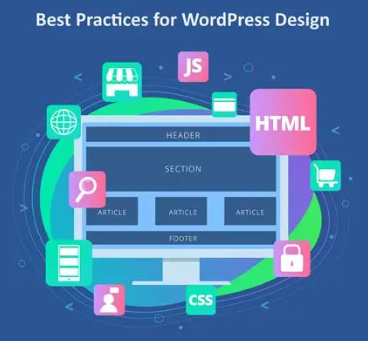Designing a successful WordPress website goes beyond just selecting a theme and publishing content. In 2025, users expect clean layouts, fast-loading pages, mobile responsiveness, and intuitive navigation. Whether you’re designing a portfolio, blog, business website, or eCommerce platform, following WordPress website design best practices ensures your site delivers a seamless experience that attracts visitors and converts them into loyal users.
This guide highlights the most important best practices for WordPress website design, from layout and responsiveness to performance and SEO.
1. Choose a Responsive and Lightweight Theme
One of the first and most critical steps in WordPress website design is selecting the right theme. A good theme should be:
-Responsive (mobile-friendly across all screen sizes)
-Lightweight and optimized for speed
-Compatible with major plugins
-SEO-ready
Themes like Astra, GeneratePress, and Kadence are excellent examples of modern, fast-loading, and customizable WordPress themes. A responsive design not only improves user experience but also contributes to better SEO rankings.
2. Prioritize Website Speed and Performance
Visitors will abandon your website if it loads slowly. In fact, studies show that even a 1-second delay in load time can reduce conversions by 7%. That’s why performance is one of the most crucial best practices for designing a WordPress website.
Here are a few tips:
-Use caching plugins like WP Rocket or W3 Total Cache.
-Optimize images using tools like ShortPixel or Smush.
-Minify CSS, HTML, and JavaScript files.
-Use a reliable hosting provider with server-level optimization.
-Enable lazy loading for images and videos.
A well-optimized site not only improves user retention but also scores higher in Google’s Core Web Vitals.
3. Create a Clear and Consistent Navigation Structure
Website navigation should be intuitive and easy to follow. If users struggle to find information, they’ll leave — no matter how beautiful your site looks. When implementing WordPress website design best practices, make sure your navigation includes:
-A clear menu structure with no more than 5–7 main items
-Dropdowns for secondary pages
-A search bar
-Sticky navigation for better usability on long pages
Also, include a logical footer with important links like contact information, privacy policy, and site map.
4. Use High-Quality Visuals, But Keep It Minimal
Visual elements such as images, icons, and videos can greatly enhance the appeal of your WordPress website — but only if used correctly.
Best practices for visuals include:
-Use original or high-resolution stock images that reflect your brand
-Maintain visual consistency with fonts, colors, and button styles
-Avoid clutter — whitespace improves readability and focus
-Compress images before uploading to maintain fast load times
Minimalist design is trending in 2025. Clean layouts with focused calls-to-action tend to convert better than visually overwhelming pages.
5. Mobile Optimization Is Not Optional
Over 60% of web traffic now comes from mobile devices. If your WordPress website design doesn’t work well on smartphones and tablets, you’ll lose a large portion of your audience.
To ensure full mobile optimization:
-Use a responsive theme (as mentioned above)
-Test your design on different devices and browsers
-Ensure touch-friendly elements (buttons, menus, forms)
-Avoid popups that block content on small screens
Google’s mobile-first indexing also prioritizes mobile versions of websites for search rankings.
6. Implement Strong Branding and Visual Identity
A successful website reflects your brand consistently across all pages. Pay attention to:
Typography – Use readable, web-safe fonts and maintain hierarchy.
Color palette – Stick to 2-3 main brand colors.
Logo placement – Typically top left or centered in the header.
Favicon – Small but important for brand recognition.
Consistent branding builds trust and makes your site look professional and reliable.
7. Optimize for Search Engines (SEO)
Designing with SEO in mind is one of the most valuable WordPress website design best practices. Good design and good SEO go hand-in-hand.
Here’s how to integrate SEO into your design process:
-Use an SEO plugin like Yoast SEO or Rank Math
-Optimize headings (H1, H2, H3) for keyword relevance
-Ensure clean URL structures
-Add alt text to all images
-Build internal linking between pages
-Ensure your website is indexable and crawlable
When combined with great content and fast performance, SEO-friendly design leads to higher search visibility and organic traffic.
8. Prioritize Accessibility
Accessibility ensures that your website can be used by everyone, including those with disabilities. This is not only ethical but may also be required by law depending on your country.
Best practices include:
-Use proper heading structure (H1-H6)
-Provide alt text for images
-Ensure keyboard navigability
-Use sufficient color contrast
-Add ARIA labels where necessary
Tools like the WAVE Accessibility Tool can help audit your site’s accessibility.
9. Use Page Builders Wisely
Page builders like Elementor, Beaver Builder, and WPBakery can speed up the design process. However, overusing them can lead to bloated code and slow performance.
To follow best practices:
-Use minimal elements per page
-Avoid excessive animations and scripts
-Stick to one page builder per site
-Regularly clean up unused sections and templates
If possible, consider using block-based design with the native WordPress Gutenberg editor for leaner code and better performance.
10. Regularly Test and Update
Even the best WordPress designs require continuous testing and improvement. Here’s what you should do regularly:
-Test for broken links
-Update themes and plugins
-Check responsiveness
-Monitor page speed
-Collect user feedback
-Use tools like Google Analytics, Hotjar, or Microsoft Clarity to understand user behavior
Regular testing ensures your design remains effective as technology and user expectations evolve.
Conclusion
Designing an effective WordPress website in 2025 involves more than just choosing a pretty theme. By following the best practices for WordPress website design, you create a site that is not only visually appealing but also fast, secure, accessible, and user-friendly.
From optimizing performance and mobile responsiveness to improving SEO and navigation, these strategies ensure your site is built for long-term success. A well-designed WordPress website enhances user experience, increases engagement, and ultimately drives better results for your brand or business.

